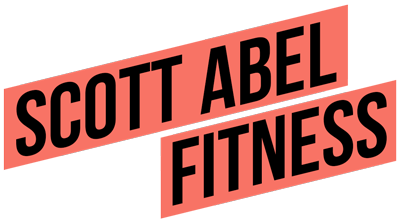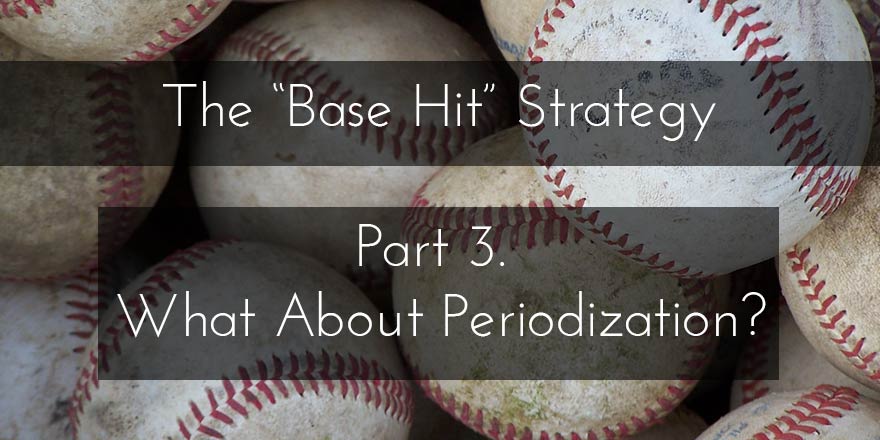I’ve been explaining the idea of embracing a “base hit strategy” that I use with many of my clients when their biofeedback warrants it. (Read Part 1, or Part 2 here.)
The base-hit strategy is a way to get your mind in command of your workout. I will often assign people a base-hit week of dialed back workout intensity and they will write me a week later saying they can’t believe the difference: everything comes back to them, including their strength, energy, and vitality. All it took was actually listening to biofeedback, factoring in life stressors, then responding accordingly. As I said in both Part 1 and Part 2. this whole “Go Hard or Go Home” notion is nonsense for people with real lives.
“But What About Periodization?”
When I explain the base-hit strategy to some clients, I sometimes get comments or questions about “periodization training.” Some neophyte trainee will think none of this applies to them because they are on a “periodization schedule.”
Well, first, that usually sets me off as this term is being misused more and more. If you read my book The Abel Approach you will know I am not fond of the term “periodization.” It has an extremely limited application as far as I am concerned. Sure, for powerlifters, and strength performers the term and the application both make sense in a limited context, but for people training for other reasons, and for those of you training for weight-loss or cosmetic physique enhancement, the term really has no value.
I prefer Vern Gambetta’s term “planned performance training.”
PPT allows for subjective variances in training intensity based on the reality of today and the right now. It doesn’t try to pretend that real life can be 100% managed for 12 weeks or several months down the road.
Strength and lifting expert Dan John said, “Clearly, contemporary models of periodization and peaking have severe limitations.” Experts know this and accept this. It’s when concepts get out of the hands of experts and into the hands of eager trainees that the concepts get misunderstood, misapplied and bastardized.
Linear periodization programs and ones that include “back-off weeks” all look great on paper. But very few people can train in a vacuum away from the real-world of ‘other’ concerns. Real-life always enters the picture and disrupts whatever you've got planned on paper. It’s fine to plan to call up and escalate training intensity or strength increases on a week to week basis. But real-life issues can get in the way of that. The base hit mindset is about employing ways to still workout and stay in the game, while honoring that your body may be too drained to hit that workout like a piece of paper says you should hit it.
What if you get into a fender bender on your way to the gym today? Is your workout still going to go exactly as planned? Maybe you had a serious disagreement with your spouse last night and you barely slept at all. Is it going to make sense to go to your workout the next day and try to “max out” because a piece of paper (or, worse, an online calculator) tells you you're supposed to “today.”
There are dozens of circumstances that can make your day turn on a dime in terms of mood, available energy and your sense of vitality. The base-hit mindset allows you to still stay consistent with your training without exhausting and depleting yourself in the process. The linear periodization plan of numbers and percentages just doesn’t realistically account for day to day life variances.
Periodization in real life: an example
Take for instance Kevin “The Machine” Weiss. The guy is a 2-time World Champion Powerlifter (!). Because he competes in powerlifting Kevin is someone for whom a periodization plan actually makes sense, and he has his own version that he uses.
But while preparing for one competition Kevin tweaked his back a bit during training. He knew he couldn’t just go into the gym and do his training as it was planned “on paper.” Life got in the way, and he accounted for that. He had adapted and make concessions. He still won his contest, as usual. but he didn’t attempt any serious PR’s.
Had he been trying to follow the periodization plan to the letter would likely have never even made it to the competition.
This is where the base-hit strategy comes in.
There will always be some combination or variation of mental, emotional, or in Kevin’s example “physical” reasons to employ the base-hit mindset to training – for a session or even a week. This base-hit mindset keeps you in the game, and keeps your training consistent. You still make good progress this was as well.
No one is saying you should under-train all the time and dog it, but if the mind and body are tired you need to be smart about training. That is not the time to let your ego dictate training intensity.
And while what I am about to say may “seem” counter-intuitive if you remove your ego from the equation, then the truth is this: Any time a trainee working very hard and consistently is allowed a bit of extra rest and recuperation, even in the form of “dialing it back” then performance will increase. “More work” or “harder work” are seldom the answer to stalled progress for someone who trains hard and consistently. This is especially true of an advanced trainee with many years of training under their belt. Active recovery in the form of the “base hit strategy” fits this application perfectly, whether it be for a single workout, or a whole training week.
Remember. in baseball, a base hit keeps the inning alive, and keeps the offence on the field. A base hit workout keeps you and your program in concert with each other as well. Just because you can't “go hard” doesn't mean you “go home.”
Conclusion
And there you have it.
This 3-Part article on my “base hit strategy” toward workout intensity outlines training intelligently. That means factoring in real-life, and factoring in your daily available energy resources, including your physical, mental and emotional resources.
Now having said all of that above, I want to include this caveat as well in regard to specific exercises. There are certain exercises that should never be trained to absolute failure either because of neural exhaustion or risk of injury as form breaks down. Lunges, bent rows, deadlifts (of course), and squats come to mind. Training to absolute failure for multiple sets on an exercise like the squat is a tremendously taxing event, and makes recovery for the next day or week very difficult.
So many trainees never make that connection between overdoing it one week and underperforming for the next few weeks that follow. Then they're left wondering “What’s wrong? What happened?”
The base-hit strategy is an important training strategy to adapt for real people living in the real world with real life stressors that can vary day to day and influence both the desire and the willingness to train hard. The base-hit strategy is a way to vary intensity levels for training that allow you to stay consistent with your training program in spite of other things going on around you.
And consistency is more important than intensity.
(Have I said that already?)
As usual, some of you will get it, some of you will not.

